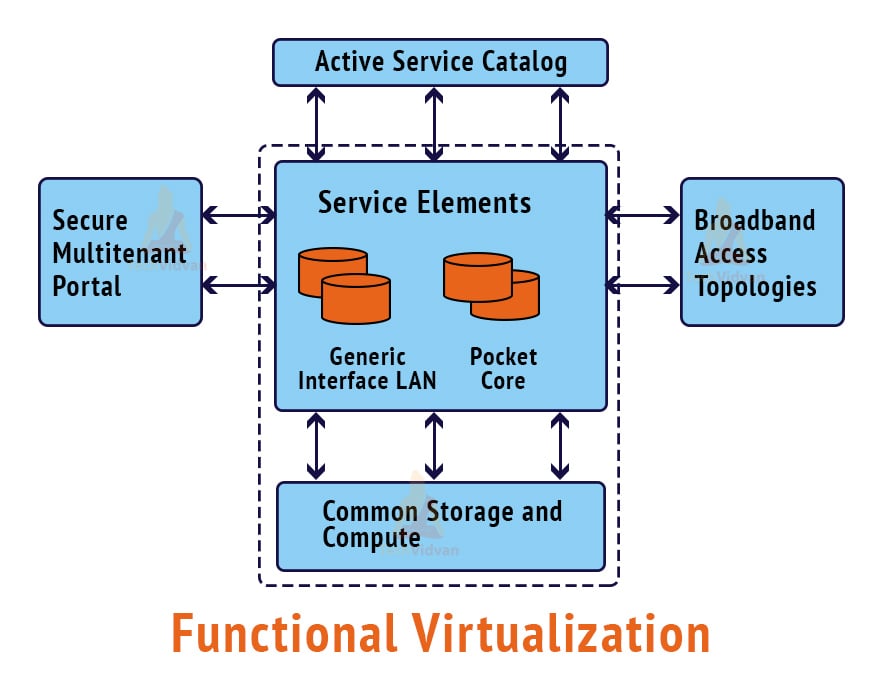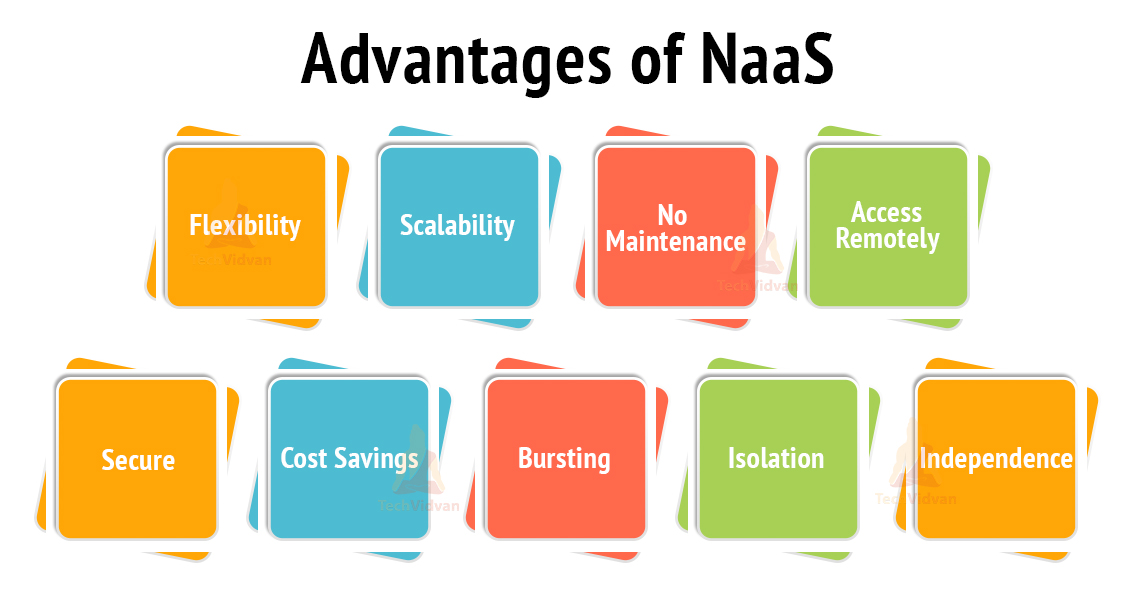Cloud Computing- NaaS
In the previous articles, we have seen about Infrastructure-as-a-Service (IaaS). And today, we will move on towards Network-as-a-Service (NaaS). We will cover the essential topics of NaaS. So, readers, let us begin today’s journey.
What is Networking-as-a-Service (NaaS)?
Network-as-a-Service will provide users with complete networking infrastructure along with security. It is mainly for the users who do not want to build their own application. With NaaS, it is possible for users to deploy with custom protocols.
NaaS helps the user to reduce and deduct the cost of hardware-centric VPN, load balancers, VPNs, firewall applications, and Multiprotocol Label Switching connections.
The users have the facility to scale up and scale down according to the requirements. Services can be deployed very easily and quickly.
NaaS is similar to other cloud services, and the clients can run networking functions with the help of software. Users or companies can set up their own networks without the hardware. The main requirement is the internet.
A new policy of routing traffic and security policies in NaaS has a significant impact on an organization’s networking architecture.
The network service provider will take the responsibility to provide the networking infrastructure. It means the Third Party can deliver the network infrastructure. Sometimes NaaS also includes virtualization by using a protocol named OpenFlow.
Mobile NaaS
Mobile NaaS provides users an additional efficient and flexible control on mobile devices. It takes the help of virtualization to ease the architecture and thus builts an efficient process.

How did NaaS develop?
When most organizations were configuring their network infrastructure, the web wasn’t considered a trusted place to conduct business. They built their own internal private versions of the web and connected facilities with rented links.
They needed to configure their own wide area networks (WANs), and every office location needed its own hardware for firewalls, DDoS protection, load balancing, etc.
Enterprises also needed to line up dedicated connections between each area employing a method like MPLS.
When all the employees of the organization get connected to the web rather than the internal network, their traffic had to first undergo the company networking infrastructure via a VPN before it could leave to the web.
As an example, if the organization’s headquarters is located in Austin, Texas, and a corporation employee during a branch office in New Orleans, Louisiana needs to load an internet site. Their HTTP request for the website would travel through the company VPN, across an MPLS link to the headquarters in Austin (about 800 kilometers away), then bend the broader Internet.
This model quickly became inefficient as some business activities began getting into the cloud. Let us imagine the New Orleans employee frequently used a SaaS application, meaning they needed to constantly load content over the web.
Their requests, and therefore the demands of other employees, would become bottlenecked within the Austin data center, slowing down network service.
In addition, more capabilities became available through the cloud as cloud computing became more efficient. The IT Team of an organization does not have to worry about building and maintaining the DDoS mitigation, firewalls, load balancing, and various networking functions with the help of the Cloud.
For these reasons, NaaS may be a more efficient option than counting on internally maintained WANs that need constant maintenance and sometimes create bottlenecks for network traffic.
By adopting NaaS, organizations can connect their cloud applications or services directly with the help of a virtual network. It is the responsibility of the external vendor to manage and protect more than internal IT teams to practice and be active with the on-demand network services.
In today’s scenario, the organization adopts a NaaS model. The New Orleans-based employee will never have to wait for their web traffic to travel through the interior corporate infrastructure.
Instead, they simply hook up with the web and check-in through a browser, and that they can access all the cloud services they have.
The service provider will take responsibility to secure the browsing activity, protect their data, and route their web traffic wherever it must go, as efficiently as possible.
How is NaaS Delivered?
The user has to log in to the web portal of the cloud provider, where they will receive an Online API to access NaaS. Here the user has the right to access and customize the route. And the user has to pay the billing amount according to the used capacity. There is also an option for the user to cancel or turn off the power at any moment.
Requirements of NaaS
One of the main requirements is integrating current DC hardware because the existing DC constitutes a significant investment. The use of commodity networking equipment reduces the value of massive DC deployments.
NaaS should also expose the natural programming model, the high-level model. Moreover, it shouldn’t reveal the complete complexity of physical topology within the DC.
The third requirement is that NaaS should support various applications, running concurrently unaware of each other. This whole thing is named scalability and multi-tenancy isolation.
Features of NaaS
Now let us discuss the characteristics of NaaS
1. NaaS authorizes the users to directly access the internet securely. Also, it permits the users to run custom-developed routing protocols.
2. Virtualized Network helps NaaS to provide network service to the users. This feature is beneficial for users from the issue of developing and managing infrastructure. So, the users can focus on development and their business.
3. It provides users with a virtual environment that helps them to reduce the physical cost and maintenance.
4. One of the main features is remote access, by which the users can access the data from any location by simply having a stable internet connection.
NaaS Architecture
In NaaS architecture, the network devices can execute tenant code. It is responsible for the execution of the tenant code in the NaaS Box.
NaaS boxes can be unified into the same switch hardware. It can be implemented with various devices connected with the help of high-level bandwidth links. The NaaS box hosts the elements of network processing materials for performing application-specific process packets that travel through them.
NaaS Service Model
NaaS offers 3 Service models, and they are as follows:
1. Bandwidth-on-Demand
Bandwidth-on-Demand is a technique for assigning the capacity. It ultimately depends upon the requirements between various users and nodes. The rates can be modified according to the traffic demand of nodes that are connected to the links.
2. Virtual Private Network (VPN)
The second service on the list is Virtual Private Network (VPN). This service integrates with the private network and its resources. VPN includes networks like the public internet. It authorizes the host to transmit and receive the data across the shared secret network and its functions and policies.
3. Mobile Network Virtualization
The network operator develops and manages the network. Later it sells its software to a third party. The NaaS includes as follows:
- Scalable and user-friendly
- Multicast protocols
- Security firewall
- Intrusion detection and prevention
- Wide Area Network (WAN)
- Virtual Private Network (VPN)
- Bandwidth on demand
- Custom routing content monitoring
- Filtering.
The NaaS providers focus on some particular areas such as:
- Ultra-secure connectivity
- Ultra-simple configuration
- Provides services to mobile and temporary locations.
NaaS is the main advantage to small and middle-size businesses. It provides benefits to the users who have no investment in the Wide Area network. It is popular because it eliminates the cost of capital investment, and thus, it is mainly preferred over other models.
Advantages of NaaS

1. Flexibility: In the cloud, changes in the network are made with the help of software, not via hardware. It is easy for the users to reconfigure their networks as per requirements.
2. Scalability: NaaS is more scalable than traditional hardware-based services. The companies can simply rent the benefits instead of purchasing and installing the hardware.
3. No Maintenance: It is the responsibility of the cloud provider to maintain the networks, their managing software and hardware upgrades.
4. Access Remotely: The users can access its resources from anywhere and from any device. But without using a VPN it requires strong access controls. All users must have their login credentials and robust internet connectivity.
5. Secure: NaaS provides users with many security components like firewalls. It results in the tight integration between network and network security.
6. Cost Savings: This factor depends upon the cloud vendor. The users can purchase cloud services rather than developing their own infrastructure. The user has no responsibility to acquire and maintain the hardware. It is the responsibility of the cloud vendor who has to provide the service.
7. Bursting: The user will have to pay for a high capacity network only on the requirement.
8. Isolation: The traffic of the user gets isolated logically.
9. Independence: Every user is separate or independent and can segregate the network.
Challenges of NaaS
1. Compatibility: The NaaS vendor’s infrastructure might not be compatible with legacy systems that are still using the older hardware, on-premise-based applications, etc.
2. Legacy data centers: In many enterprises, essential applications and processes still run in on-premise data centers, not the cloud. In NaaS, the following process drives the migration process slightly more challenging.
3. Vendor lock-in: Moving to a cloud service always introduces the danger that an enterprise may become too reliant on a particular service provider. If the service provider’s infrastructure fails or raises its prices, vendor lock-in can have significant repercussions.
Naas Network Agility
NaaS offers users the flexibility to pay for the services depending upon the usage and scale as per business changes. It also authorizes the users to monitor, manage networking services and keep an eye to track billings and usage. NaaS services can be ordered, deployed, and co-managed on demand.
NaaS Examples
Holistically, NaaS is often applied to a gaggle of applications and services. E.g., Aryaka and Pertino provide WAN and secure VPNs as a service, Amazon, on the other hand, offers web-hosting, storage, and personal cloud as a service. In contrast, Akamai offers CDN as a service, and a few service providers provide “Bandwidth On Demand” additionally to the hosted networks as a service.
The benefits arising out of NaaS are driving its market expansion. For instance, in 2016, the Network as a Service market was valued at $1.85 billion, as per data from Statistics MRC, and by 2022 it’s going to reach nearly about $22.5 billion valuations; at a compound annual rate of growth of 51.60%, over six years.
However, NaaS has got to add up within the context of a company’s infrastructure.
Conclusion
As the technology develops, the software also increases. So, in today’s article, we have gained experience with a new cloud service. Network-as-a-Service (NaaS) is a unique and trendy technology among users and businesses.
